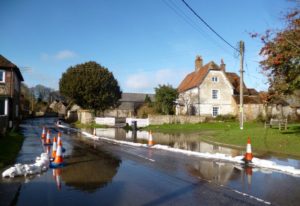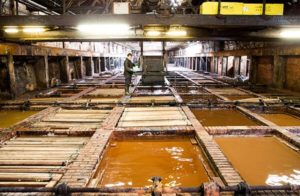Groundwater Flooding and Water Supplies – The Delayed Deluge
The role of groundwater in providing secure water supplies to the nation and supporting a healthy surface water environment is vital.
In recent years, England and Wales has experienced exceptional swings that have led from drought to groundwater flooding in as little as four months. This has been especially the case this winter in London and the South East.
We take a look at this lesser known and more unpredictable flood risk and its impact on property, likely to become far more common as our climate changes.
What is Groundwater Flooding?
Groundwater is a general term that refers to any water found beneath the surface that fills pores or cracks in the underlying soil and rocks. It is most commonly found in low-lying areas underlain by aquifers, such as chalk or sandstone, or localised sands or river gravels in valley bottoms.
Because of its subterranean existence, it is not normally “seen”, emerging only in extreme circumstances. Underneath Large areas of southern England are aquifers – huge rock layers that can hold a lot of water. They are a precious store of water supplies for the populous south, but they can also be a curse.
When the water level rises, it can seep out of the rock later in a slow release. Following persistently wet winters, such as the one we have just had, flood levels can be easily reached and will continue to flood well into spring.
What are the impacts of Groundwater Flooding?
Once flood water reaches the surface it will find its own often indiscriminate route. Some flows will follow usually dry valleys, or it could just seep out where the chalk meets a more impervious clay layer. Patcham, near Brighton in West Sussex regularly suffers from sudden emergence in gardens and across roads and paths, paying little attention to what is in its way.
As it travels to the surface, it can also ingress to basements, tunnels and sewer networks. Any cracks in pipes can then suffer severe water damage that can disrupt supplies or create potential effluent contamination.
On new developments with sustainable drainage systems (SuDS), it can also interrupt and overload drains and ponds.
It is the severity and duration of groundwater flooding on property assets versus other types of flooding that is its distinctive hallmark. Locally, properties can be affected by fluctuating high levels of groundwater for many weeks, with no way of drying out. A river or surface flood tends to be immediate, severe and then recede allowing for a quick response. Groundwater sometimes does not give that option.
What are Groundwater Levels like Now?
Through Christmas and into New Year, groundwater levels in southern England rose dramatically following heavy rainfall. Given the accumulations from a wet autumn, levels in southern England reached notably or exceptionally high levels compared to the trend.
The Environment Agency (EA) continues to report that groundwater levels in Dorset, Hampshire, East Surrey and South London have been rising throughout the winter following higher than average rainfall. Levels have continued to increase through most of February in response to rainfall received during Storms Ciara and Dennis and have continued to rise further with the early March heavy rainfall event.
Dorset has an extensive network of tributaries in deep chalk valleys called bournes which are directly fed by groundwater charging. Flooding of properties in the Winterbourne villages has continued, with the Environment Agency (EA) reporting that pumping of properties is still ongoing as water ingresses to property and sewer systems some 2-3 weeks after the festive deluge.
Properties with deep basements in and around Purley could soon experience flooding thanks to the Caterham Bourne, a groundwater stream that rarely flows but is now rising rapidly. Properties are being defended with sandbag walls. The EA is also installing additional pipework in the rear gardens of affected homes to make sure the watercourse runs freely.
There are many similar hidden streams in West London that could also affect high value basement conversions. The London Borough of Hammersmith and Fulham’s 2017 Flood Risk Strategy highlights that the majority of the southern half of the borough is considered to be potentially at high risk of groundwater flooding.
The EA and Flood Forecasting Centre (FFC) continue to monitor boreholes levels up to 60 days in advance, given the lag in flood incidents after rainfall events. Alerts can be provided to residents to take action and maintain resilience.
As the ground is already saturated in the groundwater flood prone areas, this will inevitably top up levels and will store up further groundwater flooding through March.
Identifying Groundwater Risks in Conveyancing Transactions
Groundwater can be challenging to advise on as an environmental risk in property search due diligence.
As a conveyancer, key things to ask your client to look out for include:
- A local history of groundwater flooding – especially any evidence of damage and repair from 2000/01 and 2013-14 and, perhaps, right now.
- Located on a permeable unconfined aquifer, river floodplains or low-lying area
- Has a basement or subterranean room (especially in London)
- A nearby feature, like a local spring-fed ponds
- An history of cellar pumping
A More Forensic Risk Analysis
The EA has a basic map of groundwater risk at 1km resolution, which is not good enough for property searches. Data is now improving all the time in order to translate potential risks into a more scientific understanding.
The Future Climate Info environmental search and flood search reports contains groundwater flood risk data at a 5m resolution.
Where a groundwater risk is highlighted, our flood data partners at JBA can then undertake a more forensic Flood Review. The results provide initial opportunities for property level resilience measures that may benefit the property.
Understanding groundwater risk is important as many insurance policies exclude groundwater as “local flooding”.
For more information on Future Climate Info’s environmental risk reports with JBA’s unique Flood Review service, contact us on 01732 755 180 or email [email protected].
Kindly shared by Future Climate Info


















